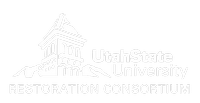Adaptive Management
What is adaptive management?
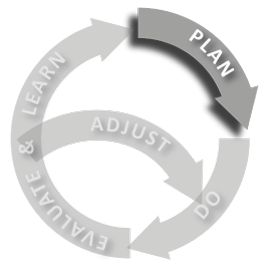 Adaptive management is often referred to as ‘learning by doing’. More fundamentally, adaptive management provides a pathway for proceeding forward with managing complex systems or projects in the face of uncertainty. The classic adaptive management loop consist of five components: 1) Planning, 2) Doing, 3) Evaluation, 4) Learning, and the option to ‘Adjust’ as needed. That ‘adjustment’ on the basis of evaluating what was done can lead to adjustment of conceptual models, adjustment of plans or adjustment of actions.
Adaptive management is often referred to as ‘learning by doing’. More fundamentally, adaptive management provides a pathway for proceeding forward with managing complex systems or projects in the face of uncertainty. The classic adaptive management loop consist of five components: 1) Planning, 2) Doing, 3) Evaluation, 4) Learning, and the option to ‘Adjust’ as needed. That ‘adjustment’ on the basis of evaluating what was done can lead to adjustment of conceptual models, adjustment of plans or adjustment of actions.
Adaptive management uses the formulation of a plan based on the best available information and articulation of a conceptual model of how the system works with predictions about how it should response to management actions. One of the hallmarks of good adaptive management is that, multiple competing responses to management actions can be identified prior to actions (i.e. ‘DO’ing). A decision/plan can be made on the basis of the predicted response, but if alternative, unforseen, or undeseriable outcome take place instead, management responses can be identified ahead of time. This allows competing concerns to be recognized, addressed and used to help craft the plan.
Adaptive Management that is Pragmatic and Affordable
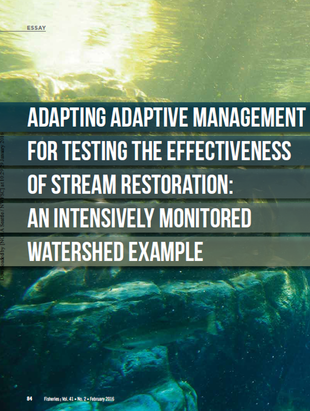 In Bouwes et al. (2016) we lay out our vision for how adaptive management can move beyond something only the biggest projects with the healthiest budgets can afford, to something we can and should as routine practice on almost every restoration project.
In Bouwes et al. (2016) we lay out our vision for how adaptive management can move beyond something only the biggest projects with the healthiest budgets can afford, to something we can and should as routine practice on almost every restoration project.
- Bouwes N, Bennett S and Wheaton JM. 2016. Adapting Adaptive Management for Testing the Effectiveness of Stream Restoration: An Intensively Monitored Watershed Example. Fisheries. 41: 2: pp. 84-91. DOI: 10.1080/03632415.2015.1127806
Some Examples of Our Own Adaptive Mangement Plans
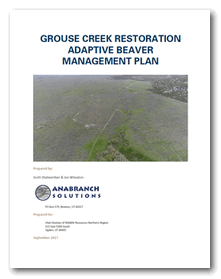 These are examples of simple adaptive management plans developed for low-tech restoration projects.
These are examples of simple adaptive management plans developed for low-tech restoration projects.
| Report Citation | Description | |
|---|---|---|
| Shahverdian, S. and Wheaton, J.M., 2017. Grouse Creek Restoration Adaptive Beaver Management Plan, Prepared for Utah Division of Wildlife Resources by Anabranch Solutions, LLC, Logan, UT. DOI: 10.13140/RG.2.2.31798.34885. | forthcoming | Grouse Creek, Utah |
| Shahverdian S, Macfarlane WW and Wheaton JM. 2016. MEMO: Westerly Creek Beaver Dam Capacity Assessment: Developing Realistic Expectations for Beaver Dam Activity. Prepared for Muller Engineering Company, Anabranch Solutions, Logan, UT, 24 pp. DOI: 10.13140/RG.2.2.34120.93446 | forthcoming | Westerly Creek, Dener, Colorado |
| Portugal, E., Wheaton, JM., Sorenson, K., Majerova, M., Hunt, B., Bouwes, N. 2015. Hardware Ranch Adaptive Beaver Management Plan. Prepared for Utah Division of Wildlife Resources. Logan, Utah. 26 Pages. DOI: 10.13140/RG.2.2.29887.30883 | forthcoming | Hardware Ranch, Hyrum, Utah |
| Portugal E., Wheaton, JM., Bouwes, N. 2015. Spring Creek Wetland Area Adaptive Beaver Management Plan. Prepared for Walmart Stores Inc. and the City of Logan. Logan, Utah. 25 Pages. DOI: 10.13140/RG.2.1.2075.336 | forthcoming | Logan, Utah |
| Wheaton JM. 2013. Scoping Study and Recommendations for an Adaptive Beaver Management Plan. Prepared for Park City Municipal Corporation. Logan, Utah, 30 pp. DOI: 10.6084/m9.figshare.903648. | 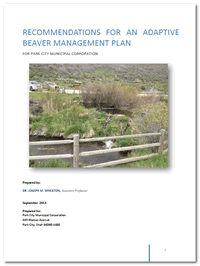 |
Park City, Utah |
| Wheaton J, Bennett S, Bouwes N, and Camp R. 2012. Asotin Creek Intensively Monitored Watershed: Restoration Plan for North Fork Asotin, South Fork Asotin and Charlie Creeks, Eco Logical Research, Inc., Prepared for Snake River Salmon Recovery Board. Logan, UT, 125 pp. | forthcoming | Asotin Creek, Washington |
| Pollock M, Wheaton JM, Bouwes N and Jordan CE. 2011. Working with Beaver to Restore Salmon Habitat in the Bridge Creek Intensively Monitored Watershed: Design Rationale and Hypotheses, Interim Report, NOAA Northwest Fisheries Science Center, Seattle, WA, 63 pp. | forthcoming | Bridge Creek, Oregon |

